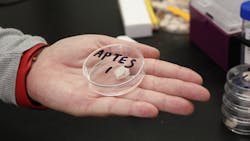Arizona researchers developing sponges to soak up PFAS
Researchers from the University of Arizona and Northern Arizona University are developing specialized, reusable sponges to remove per- and polyfluoroalkyl substances (PFAS) from water.
The team, led by chemical and environmental engineering assistant professor Vicky Karanikola, has received $1.487 million from the Arizona Board of Regents to support the research.
The durability of PFAS – the same quality that makes them useful for many applications – means it is very difficult to remove them from the environment, and the chemicals have spread into water sources in areas throughout the world, including Tucson. Removal is an ongoing process. For instance, in a separate effort, the Central Tucson PFAS Project was launched in early 2022 to remove PFAS pollution from groundwater near Davis-Monthan Air Force Base.
"PFAS contamination is a critical issue in Arizona and beyond, and we are so proud that this team, largely made up of early-career faculty members, is leading this effort," said University of Arizona President Robert C. Robbins. "By creating a more sustainable method for PFAS detection and removal, this team aims to make water safer for communities around Arizona."
Making Toxin Cleanup Stick and Unstick
Many sponges are made of cellulose — an abundant organic compound found in plants and used to make materials such as paper and textiles. To draw PFAS out of water, engineers need to use a material that can adsorb PFAS or, more simply, a material that PFAS will stick to. This part is easy, as PFAS stick to many materials, including cellulose, naturally. The team even has to use polypropylene containers for all of its experiments because PFAS can stick to glass.
While simple cellulose sponges are good for initial study of factors such as optimal pore size and density, sponges being developed for the removal of PFAS are far more complex. These will soak up PFAS-contaminated water, then squeeze out clean water while the PFAS stay stuck. Then, an extraction solution will remove the PFAS from the sponges so they can be used again.
One common method for removing PFAS from water uses granulated activated carbon, or GAC, another material to which PFAS stick quite well. A little too well, in fact. The tricky part is the unsticking. Getting the PFAS off the GAC so the carbon materials can be reused for another round of removal is expensive and difficult.
"The amount of energy you need to release them from GAC is huge," Karanikola said. "The innovation of this project is that we're focusing on a regenerable method: We want to break that barrier of just using something once and throwing it away. We are trying to find the sweet spot for absorbing it just enough to hold, but that will take the minimum amount of energy to release the PFAS into a controlled environment."
